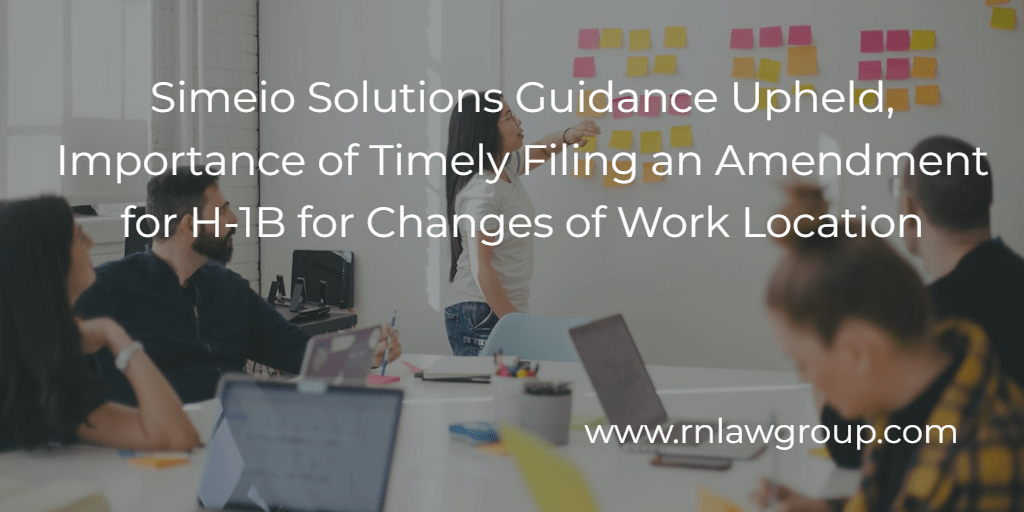
Simeio Solutions Guidance Upheld, Importance of Timely Filing an Amendment for H-1B for Changes of Work Location
In 2015, USCIS published guidance following an Administrative Appeals Office decision called Matter of Simeio Solutions, LLC. Regulations require a new or amended H-1B petition when there is a material change in the terms and conditions of the employment or the individual’s eligibility has changed. The guidance coming from of Simeio led to USCIS interpreting that a material change happens whenever an H-1B employee changes work locations that necessitates the filing a new LCA. Essentially, USCIS looks to whether the move is within the “area of intended employment,” which would not require a new LCA and thus not require a new H-1B petition, or not.
Litigation against the Simeio Guidance
In late 2020, a trade group, ITServe Alliance, sued the Department of Homeland Security (DHS) challenging the Simeio solution guidance. The challenge focused predominately on a procedural challenge under the Administrative Procedure Act (APA) that the rule was unlawful rulemaking and that USCIS lacks statutory authority to require the amended filings. Ultimately the trial court rules against ITServe and ITServe appealed to the United States Court of Appeals for the District Court of Columbia Circuit.
In June 2023, the Court of Appeals issued its ruling and upheld the trial court’s decision, and essentially upheld the Matter of Simeio guidance. The Court ultimately held that the Simeio guidance was an adjudicative action, meaning it wasn’t rulemaking that requires the APA procedure. Essentially, the Court found that the guidance was coming from one particular case and created “rules” for how that issue would be resolved in future cases. Further, the Court found that USCIS may consider LCA-related issues in exercising authority to approve, disapprove, or revoke the H-1B petitions as well as require amended or new petitions. Essentially, that this is not solely up to the Department of Labor to decide.
Is an H-1B Amendment Required?
Since the 2015 Simeio Solutions guidance is still lawful, it is important to take a look back at what it says and the impact it has on H-1B holders and H-1B petitioners. From this guidance, there are two essential times when an H-1B amendment is mandatory.
An H-1B amendment is required when there is “a change in the place of employment of a beneficiary to a geographical area requiring a corresponding LCA to be certified…” The Simeio guidance goes on to state that a move is not required when there is a “a move within an ‘area of intended employment.’” The guidance goes on to state that “if a petitioner’s H-1B employee is simply moving to a new job location within the same area of intended employment, a new LCA is not generally required…Therefore, provided there are no changes in the terms and conditions of employment that may affect eligibility for H-1B classification, the Petitioner does not need to file an amended or new H-1B.
From a practical perspective, every LCA requires the H-1B petitioner to list the work location of the H-1B Beneficiary. So when an H-1B beneficiary moves work locations, it is important to look at two aspects of the move. First, it is important to decide if the move is in the area of intended employment. Department of Labor has defined the “area of intended employment” as the “area within normal commuting distance of the place (address) of employment where the H-1B nonimmigrant is or will be employed.” DOL goes on to note that there is no rigid distance, and it could be 20-50 miles based on a number of circumstances. As a general rule, if the move is within the same Metropolitan Statistical Area, an amendment is not required. If, for some reason, the move is outside of the Metropolitan Statistical Area, look to see if the move is normal commuting distance to determine if it is in the same area of intended employment.
Once you have determined that the move is in the same area of intended employment, it is important to confirm whether there are material changes to the terms and conditions of the employment. There is not a hard and fast rule on this, but as a general rule look at whether the position is the same type of specialty occupation. That is, does the job at the new location require the same education level and skills to perform? If so, an amendment is not required.
The change of work locations applies to both in the office moves and work from home moves. If an individual moves their residence from Houston to Dallas, even though they are still working from home, this is not the same area of intended employment, and an amendment is required.
H-1B Short Term Placement
There are exceptions to the requirement for an amendment for what the guidance refers to as “short term placement” situations, utilizing the short term placement provisions to avoid an amendment require strict adherence to specific requirements. If the move is only temporary, DOL allows an individual to be placed at a site that has not been listed on an approved LCA for up to thirty (30) days. This work may be extended for up to sixty (60) days in a one year period so long as they can show that the new worksite has ties to the main worksite from the H-1B. Moreover, the employer will also be tasked with paying for the non-immigrant workers cost of lodging, travel, meals, incidentals, and other miscellaneous expenses. These are mandatory payments in order to comply with the short-term placement provisions.
The short term placement should not be used in situations where a contract is only for a month but will go longer after a trial period. The focus on short term placement should be whether there is intent to return back to the original work location.
Timely Filing H-1B Amendments
It is important to file an H-1B amendment prior to moving to the new work location. Failure to do so is a violation of H-1B status and can result in a denial of future cases or adjustment of status applications. While not common, there have been instances where USCIS has alleged fraud where an individual was moved to a location without a properly filed H-1B amendment and USCIS alleges that the company intentionally misrepresented the LCA and intended to have the employee work at the new location.
Concerns at Visa Stamping
Unfortunately, the Department of State does not always follow the Matter of Simeio guidance. There have been instances where the consulates deny an H-1B visa when there has been a move, even if an H-1B amendment is not required. This mainly happens when there is a change of end-clients that the Beneficiary is working for, and we have not seen it as much for strict work from home situations. However, it is important to review this with your petitioner or attorney prior to traveling to determine if it is best to file an H-1B amendment.
Conclusion
In conclusion, the Matter of Simeio Solutions guidance and the recent Court of Appeals ruling have solidified the requirement for H-1B petitioners to file amendments in certain circumstances. It is crucial to understand the impact of these regulations on both H-1B holders and petitioners. The guidance clearly states that an amendment is necessary when there is a change in the place of employment that requires a new certified Labor Condition Application (LCA). However, if the move is within the area of intended employment, a new LCA and amendment are generally not required, provided there are no changes in the terms and conditions of employment affecting H-1B eligibility. By understanding and following the guidelines set forth by the Matter of Simeio Solutions guidance, H-1B holders and petitioners can navigate the process effectively and ensure compliance with the regulations governing H-1B employment. In certain situations such as violations it may be worth talking to a qualified immigration attorney prior to taking any actions.
Reddy Neumann Brown PC, located in Houston, Texas, has been serving the business community for over 25 years and is Houston’s largest immigration law firm focused solely on U.S. Employment-based immigration. We work with both employers and their employees, helping them navigate the immigration process quickly and cost-effectively.
By: Steven Brown
Steven Brown is a Partner at Reddy Neumann Brown PC where he works in the Non-immigrant visa department and leads the Litigation Team. His practice covers all phases of the non-immigration visa process including filing H-1B, L-1, E-3, H-4, and H-4 EAD petitions. In the last two years, Steven has successfully handled over 1,000 non-immigrant visa petitions including filing petitions, responding to any necessary Requests for Evidence, and drafting motions and appeals. He has also become a key resource for F-1 students that seek guidance on properly complying with the F-1 visa regulations and any OPT or CPT issues they may have. Additionally, Steven holds a weekly conference call for companies that are part of one of the largest organizations for IT Services companies in America.

